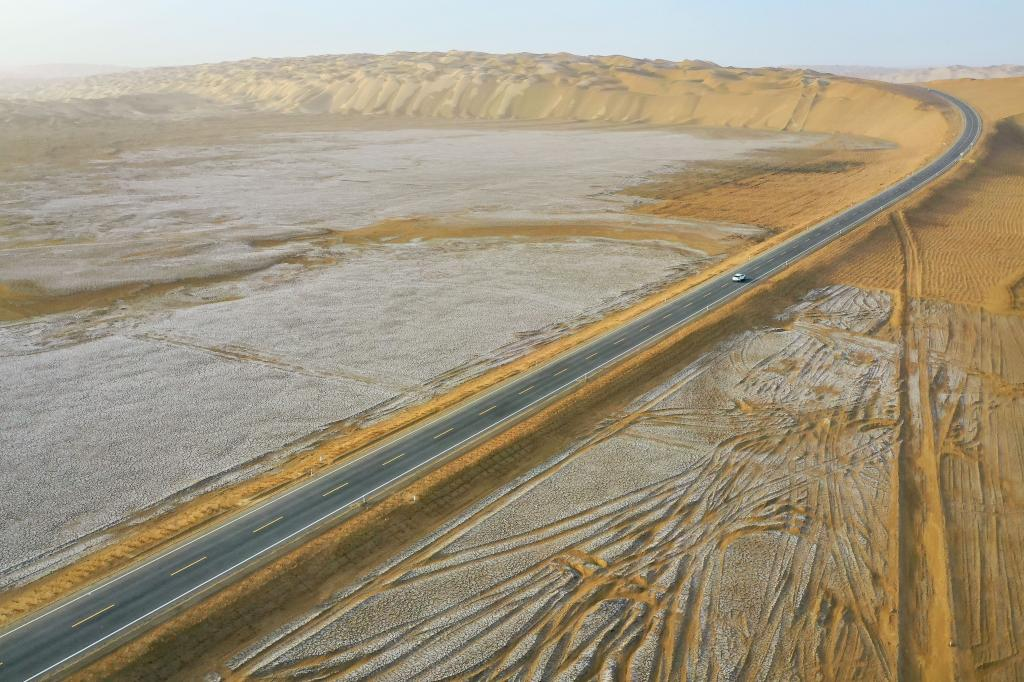
Aerial photo shows a new highway traversing the Taklimakan Desert in northwest China's Xinjiang Uygur Autonomous Region, June 26, 2022. Located in south Xinjiang's Bayingolin Mongolian Autonomous Prefecture, the highway, connecting Yuli County and Qiemo County, was put into operation on Thursday. The highway is the third one across the Taklimakan Desert, the world's second-largest shifting-sand desert. With a designed speed of 60 or 80 km per hour for different sections, the highway has a total length of 334 km, with 307 km passing through the desert. So far, China has more than 1,200 km of highways across the Taklimakan Desert. The highway has been built with an estimated total investment of about 1.75 billion yuan (about 261.5 million U.S. dollars) and its construction started in October 2017. (Xinhua/Li Xiang)
URUMQI, June 30 (Xinhua) -- A new highway traversing the Taklimakan Desert in China's northwestern Xinjiang Uygur Autonomous Region, was put into operation on Thursday.
Located in south Xinjiang's Bayingolin Mongolian Autonomous Prefecture, the highway, connecting Yuli County and Qiemo County, is the third one across the Taklimakan Desert, the world's second-largest shifting-sand desert.
With a designed speed of 60 or 80 km per hour for different sections, the highway has a total length of 334 km, with 307 km passing through the desert. So far, China has more than 1,200 km of highways across the Taklimakan Desert.
The highway has been built with an estimated total investment of about 1.75 billion yuan (about 261.5 million U.S. dollars) and its construction started in October 2017.
The highway has shortened the journey between Qiemo County and the prefecture's capital city of Korla by roughly 350 km. It is expected to effectively improve the local situation of long travel distances, high cost of living and difficulties to sell agricultural products.
Tursunjan Darman, 51, a local resident of Qiemo County, said that over the past few decades, the travel time from Korla to Qiemo has been shortened from three days to more than a dozen hours, and now it takes only six hours.
The harsh weather conditions such as frequent sandstorms, and poor access to water, electricity, communication signals and daily supplies, have made building a highway across the desert a challenging task, said Wang Yunfei, project manager with China Communications Construction Company, which undertook the highway project.
The construction teams have leveled off 32 tall sand dunes and filled up 28 low-lying lands between the sand dunes, Wang said.
To prevent the highway from being buried by sand, constructors have set up 58 million square meters of grass grids and more than 900 km of barriers along the road.
The opening of the highway has boosted the confidence of enterprises to invest in areas along the route.
A husbandry company in Qiemo County has raised more than 6,000 cattle. "The road has saved nearly 1,000 yuan for each cow in transportation and breeding costs, and we plan to invest another 500 million yuan to expand the breeding scale," said Guo Chengli, deputy manager of the company. ■
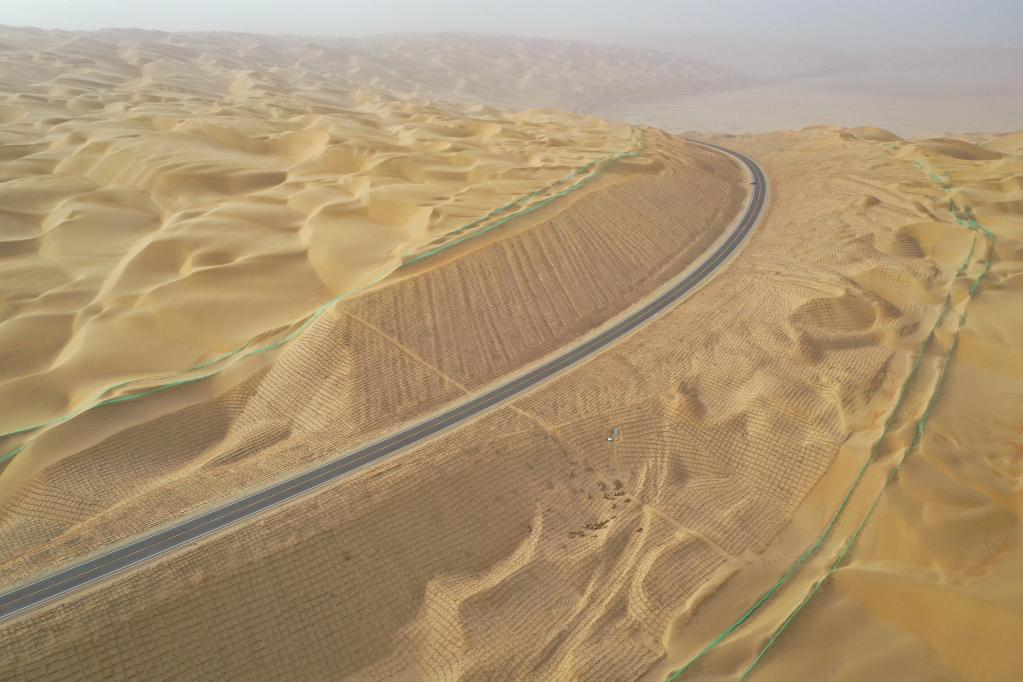
Aerial photo shows a new highway traversing the Taklimakan Desert in northwest China's Xinjiang Uygur Autonomous Region, June 26, 2022. Located in south Xinjiang's Bayingolin Mongolian Autonomous Prefecture, the highway, connecting Yuli County and Qiemo County, was put into operation on Thursday. The highway is the third one across the Taklimakan Desert, the world's second-largest shifting-sand desert.
With a designed speed of 60 or 80 km per hour for different sections, the highway has a total length of 334 km, with 307 km passing through the desert. So far, China has more than 1,200 km of highways across the Taklimakan Desert.
The highway has been built with an estimated total investment of about 1.75 billion yuan (about 261.5 million U.S. dollars) and its construction started in October 2017. (Xinhua/Li Xiang)
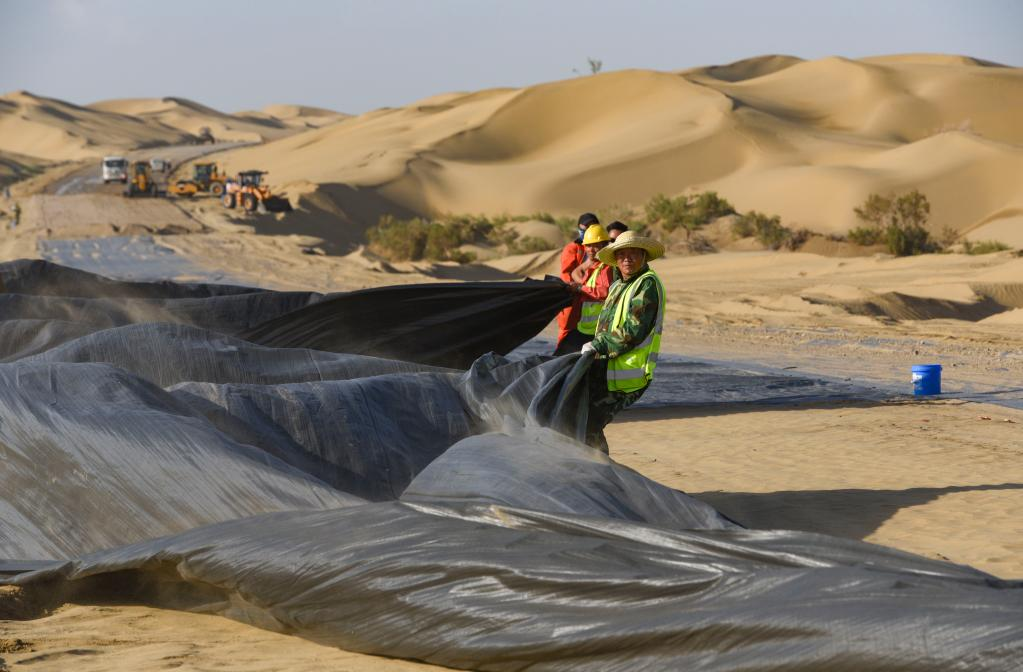
Workers work at the construction site of a new highway traversing the Taklimakan Desert in northwest China's Xinjiang Uygur Autonomous Region, July 5, 2018. Located in south Xinjiang's Bayingolin Mongolian Autonomous Prefecture, the highway, connecting Yuli County and Qiemo County, was put into operation on Thursday. The highway is the third one across the Taklimakan Desert, the world's second-largest shifting-sand desert.
With a designed speed of 60 or 80 km per hour for different sections, the highway has a total length of 334 km, with 307 km passing through the desert. So far, China has more than 1,200 km of highways across the Taklimakan Desert.
The highway has been built with an estimated total investment of about 1.75 billion yuan (about 261.5 million U.S. dollars) and its construction started in October 2017. (Xinhua/Hu Huhu)

Aerial photo shows a new highway traversing the Taklimakan Desert in northwest China's Xinjiang Uygur Autonomous Region, June 25, 2022. Located in south Xinjiang's Bayingolin Mongolian Autonomous Prefecture, the highway, connecting Yuli County and Qiemo County, was put into operation on Thursday. The highway is the third one across the Taklimakan Desert, the world's second-largest shifting-sand desert.
With a designed speed of 60 or 80 km per hour for different sections, the highway has a total length of 334 km, with 307 km passing through the desert. So far, China has more than 1,200 km of highways across the Taklimakan Desert.
The highway has been built with an estimated total investment of about 1.75 billion yuan (about 261.5 million U.S. dollars) and its construction started in October 2017. (Xinhua/Li Xiang)

Aerial photo shows cars running on a new highway traversing the Taklimakan Desert in northwest China's Xinjiang Uygur Autonomous Region, June 30, 2022. Located in south Xinjiang's Bayingolin Mongolian Autonomous Prefecture, the highway, connecting Yuli County and Qiemo County, was put into operation on Thursday. The highway is the third one across the Taklimakan Desert, the world's second-largest shifting-sand desert.
With a designed speed of 60 or 80 km per hour for different sections, the highway has a total length of 334 km, with 307 km passing through the desert. So far, China has more than 1,200 km of highways across the Taklimakan Desert.
The highway has been built with an estimated total investment of about 1.75 billion yuan (about 261.5 million U.S. dollars) and its construction started in October 2017. (Xinhua/Li Xiang)
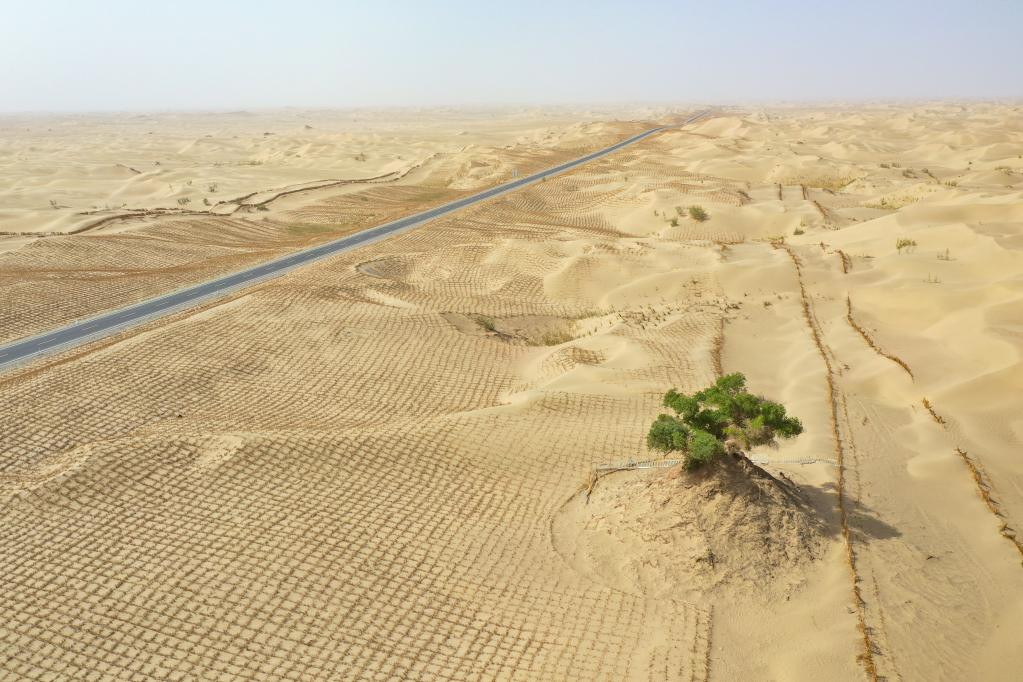
Aerial photo shows a new highway traversing the Taklimakan Desert in northwest China's Xinjiang Uygur Autonomous Region, June 26, 2022. Located in south Xinjiang's Bayingolin Mongolian Autonomous Prefecture, the highway, connecting Yuli County and Qiemo County, was put into operation on Thursday. The highway is the third one across the Taklimakan Desert, the world's second-largest shifting-sand desert.
With a designed speed of 60 or 80 km per hour for different sections, the highway has a total length of 334 km, with 307 km passing through the desert. So far, China has more than 1,200 km of highways across the Taklimakan Desert.
The highway has been built with an estimated total investment of about 1.75 billion yuan (about 261.5 million U.S. dollars) and its construction started in October 2017. (Xinhua/Li Xiang)
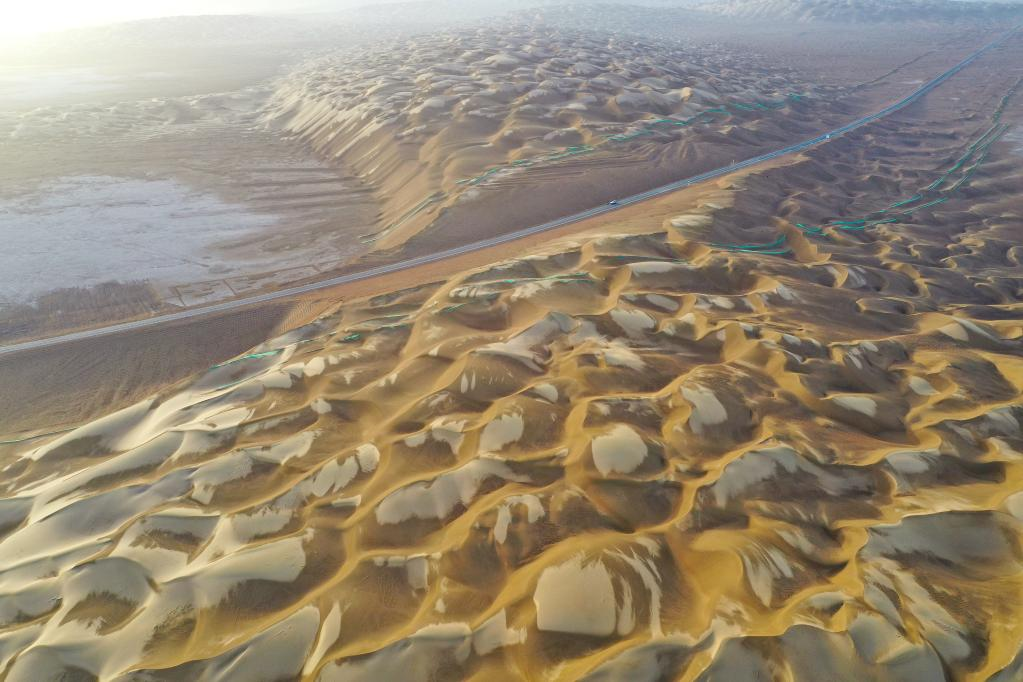
Aerial photo shows a new highway traversing the Taklimakan Desert in northwest China's Xinjiang Uygur Autonomous Region, June 26, 2022. Located in south Xinjiang's Bayingolin Mongolian Autonomous Prefecture, the highway, connecting Yuli County and Qiemo County, was put into operation on Thursday. The highway is the third one across the Taklimakan Desert, the world's second-largest shifting-sand desert.
With a designed speed of 60 or 80 km per hour for different sections, the highway has a total length of 334 km, with 307 km passing through the desert. So far, China has more than 1,200 km of highways across the Taklimakan Desert.
The highway has been built with an estimated total investment of about 1.75 billion yuan (about 261.5 million U.S. dollars) and its construction started in October 2017. (Xinhua/Li Xiang)

Workers lay grass grids along a new highway traversing the Taklimakan Desert in northwest China's Xinjiang Uygur Autonomous Region, July 10, 2018. Located in south Xinjiang's Bayingolin Mongolian Autonomous Prefecture, the highway, connecting Yuli County and Qiemo County, was put into operation on Thursday. The highway is the third one across the Taklimakan Desert, the world's second-largest shifting-sand desert.
With a designed speed of 60 or 80 km per hour for different sections, the highway has a total length of 334 km, with 307 km passing through the desert. So far, China has more than 1,200 km of highways across the Taklimakan Desert.
The highway has been built with an estimated total investment of about 1.75 billion yuan (about 261.5 million U.S. dollars) and its construction started in October 2017. (Xinhua/Hu Huhu)
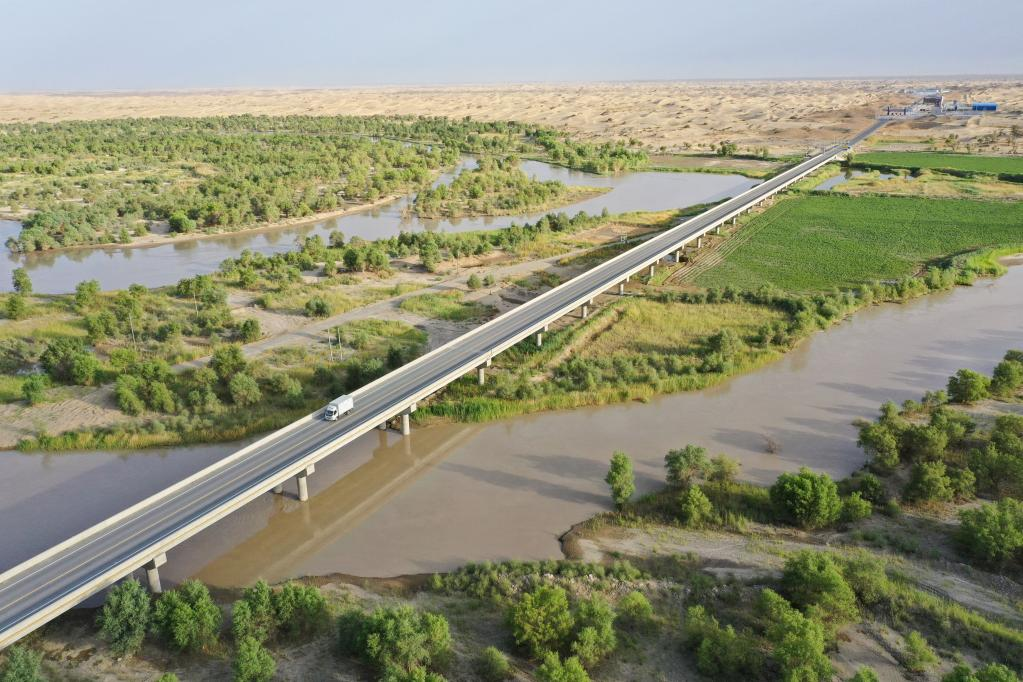
Aerial photo shows a section of a new desert highway traversing the Taklimakan Desert over the Tarim River in northwest China's Xinjiang Uygur Autonomous Region, June 22, 2022. Located in south Xinjiang's Bayingolin Mongolian Autonomous Prefecture, the highway, connecting Yuli County and Qiemo County, was put into operation on Thursday. The highway is the third one across the Taklimakan Desert, the world's second-largest shifting-sand desert.
With a designed speed of 60 or 80 km per hour for different sections, the highway has a total length of 334 km, with 307 km passing through the desert. So far, China has more than 1,200 km of highways across the Taklimakan Desert.
The highway has been built with an estimated total investment of about 1.75 billion yuan (about 261.5 million U.S. dollars) and its construction started in October 2017. (Xinhua/Li Xiang)
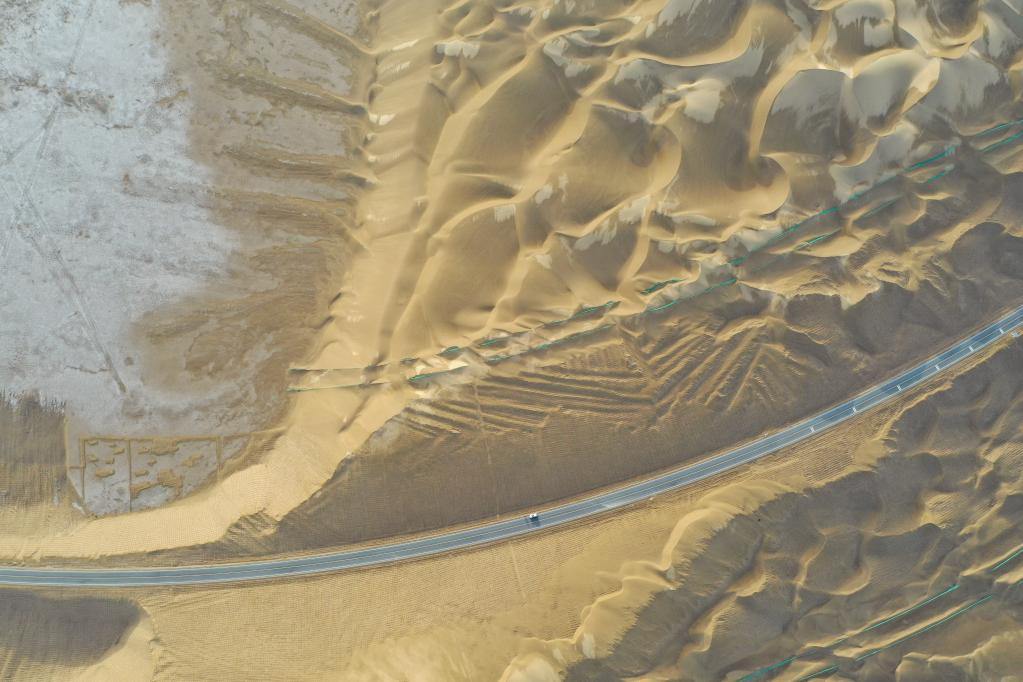
Aerial photo shows a new highway traversing the Taklimakan Desert in northwest China's Xinjiang Uygur Autonomous Region, June 26, 2022. Located in south Xinjiang's Bayingolin Mongolian Autonomous Prefecture, the highway, connecting Yuli County and Qiemo County, was put into operation on Thursday. The highway is the third one across the Taklimakan Desert, the world's second-largest shifting-sand desert.
With a designed speed of 60 or 80 km per hour for different sections, the highway has a total length of 334 km, with 307 km passing through the desert. So far, China has more than 1,200 km of highways across the Taklimakan Desert.
The highway has been built with an estimated total investment of about 1.75 billion yuan (about 261.5 million U.S. dollars) and its construction started in October 2017. (Xinhua/Li Xiang)
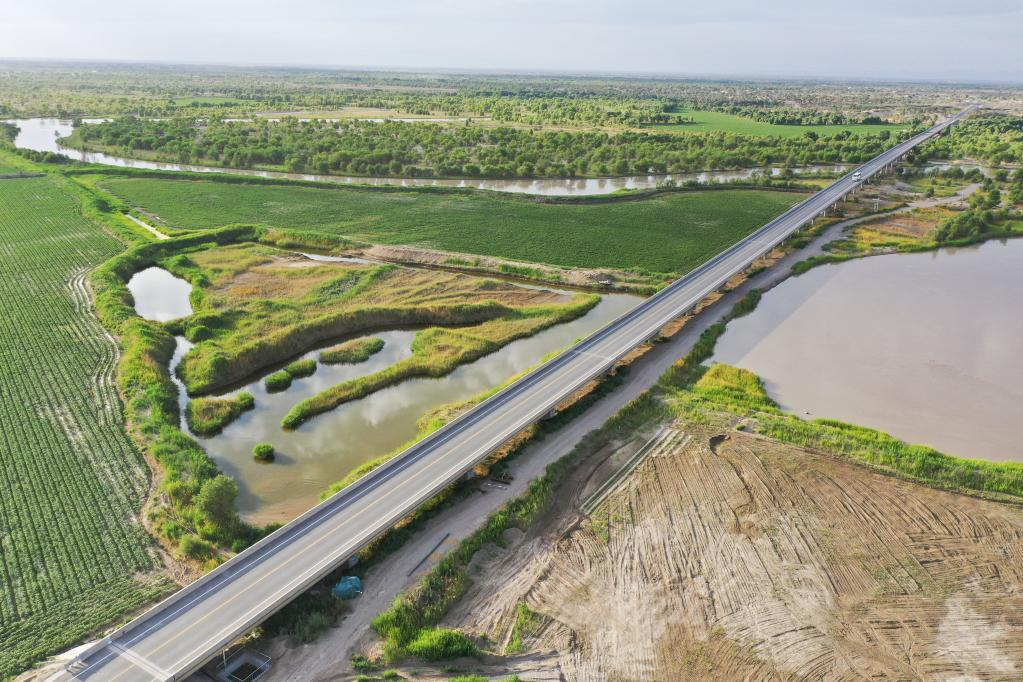
Aerial photo shows a section of a new desert highway traversing the Taklimakan Desert over the Tarim River in northwest China's Xinjiang Uygur Autonomous Region, June 22, 2022. Located in south Xinjiang's Bayingolin Mongolian Autonomous Prefecture, the highway, connecting Yuli County and Qiemo County, was put into operation on Thursday. The highway is the third one across the Taklimakan Desert, the world's second-largest shifting-sand desert.
With a designed speed of 60 or 80 km per hour for different sections, the highway has a total length of 334 km, with 307 km passing through the desert. So far, China has more than 1,200 km of highways across the Taklimakan Desert.
The highway has been built with an estimated total investment of about 1.75 billion yuan (about 261.5 million U.S. dollars) and its construction started in October 2017. (Xinhua/Li Xiang)
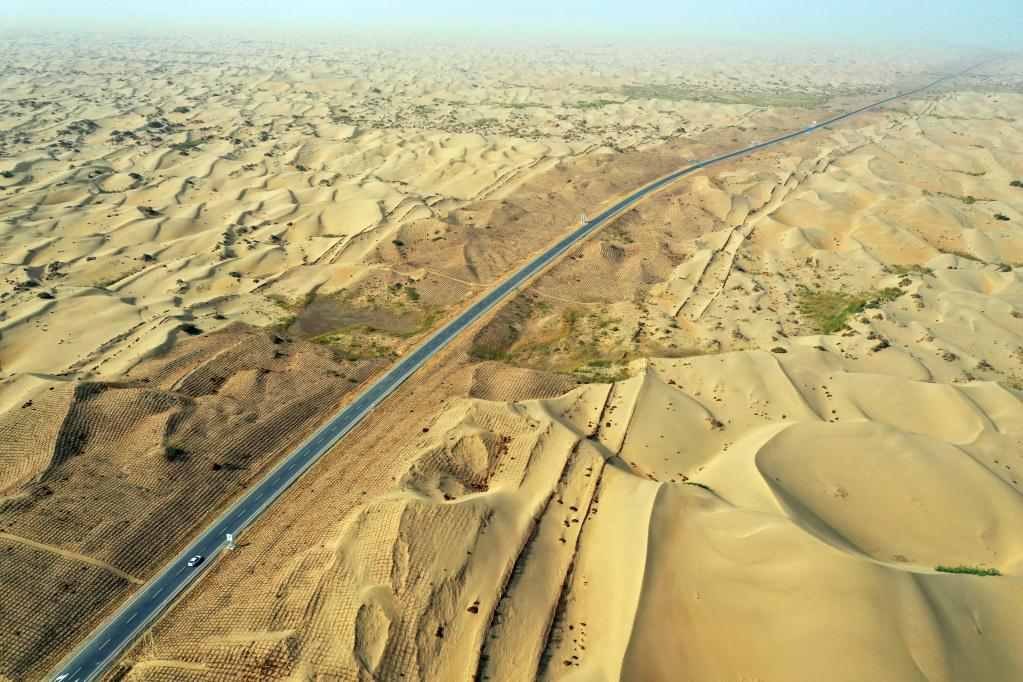
Aerial photo shows a new highway traversing the Taklimakan Desert in northwest China's Xinjiang Uygur Autonomous Region, June 30, 2022. Located in south Xinjiang's Bayingolin Mongolian Autonomous Prefecture, the highway, connecting Yuli County and Qiemo County, was put into operation on Thursday. The highway is the third one across the Taklimakan Desert, the world's second-largest shifting-sand desert.
With a designed speed of 60 or 80 km per hour for different sections, the highway has a total length of 334 km, with 307 km passing through the desert. So far, China has more than 1,200 km of highways across the Taklimakan Desert.
The highway has been built with an estimated total investment of about 1.75 billion yuan (about 261.5 million U.S. dollars) and its construction started in October 2017. (Xinhua/Gu Yu)
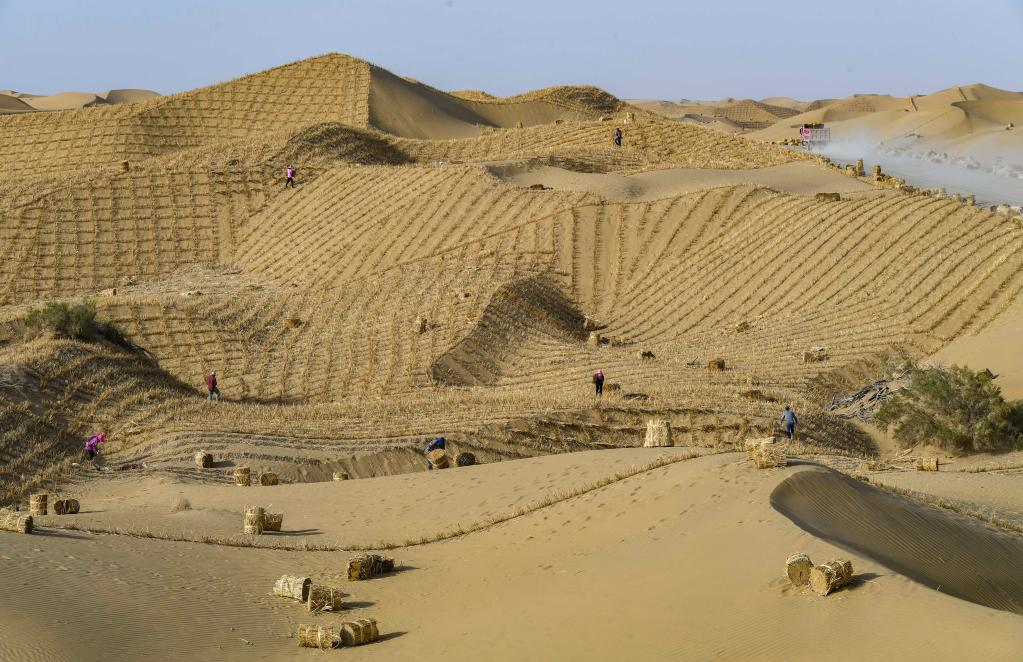
Workers lay grass grids along a new highway traversing the Taklimakan Desert in northwest China's Xinjiang Uygur Autonomous Region, July 13, 2018. Located in south Xinjiang's Bayingolin Mongolian Autonomous Prefecture, the highway, connecting Yuli County and Qiemo County, was put into operation on Thursday. The highway is the third one across the Taklimakan Desert, the world's second-largest shifting-sand desert.
With a designed speed of 60 or 80 km per hour for different sections, the highway has a total length of 334 km, with 307 km passing through the desert. So far, China has more than 1,200 km of highways across the Taklimakan Desert.
The highway has been built with an estimated total investment of about 1.75 billion yuan (about 261.5 million U.S. dollars) and its construction started in October 2017. (Xinhua/Hu Huhu)
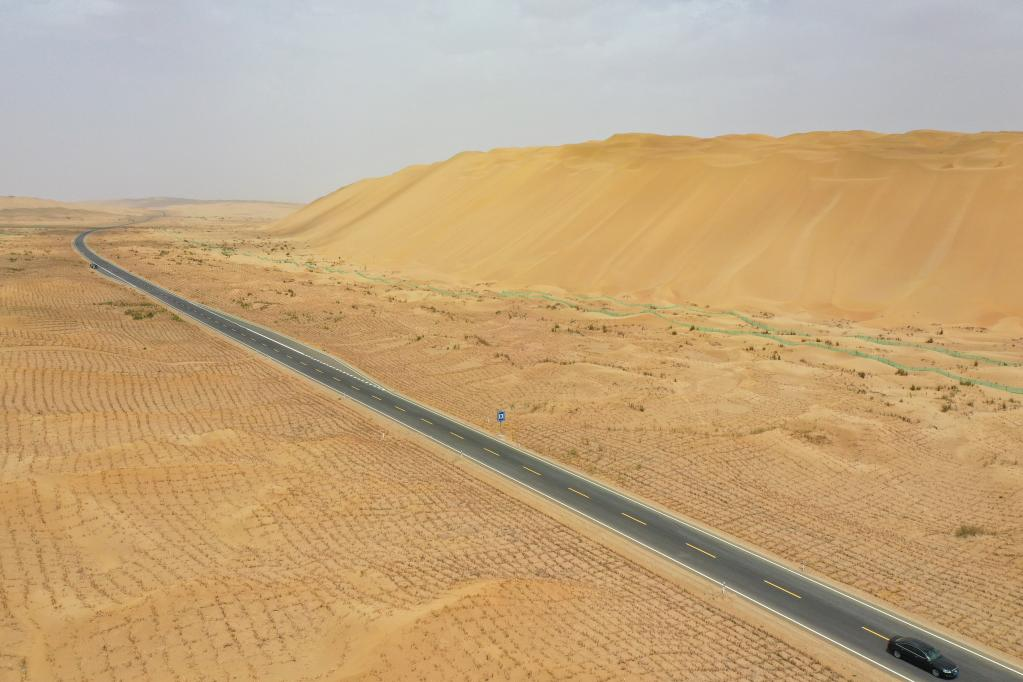
Aerial photo shows a new highway traversing the Taklimakan Desert in northwest China's Xinjiang Uygur Autonomous Region, June 25, 2022. Located in south Xinjiang's Bayingolin Mongolian Autonomous Prefecture, the highway, connecting Yuli County and Qiemo County, was put into operation on Thursday. The highway is the third one across the Taklimakan Desert, the world's second-largest shifting-sand desert.
With a designed speed of 60 or 80 km per hour for different sections, the highway has a total length of 334 km, with 307 km passing through the desert. So far, China has more than 1,200 km of highways across the Taklimakan Desert.
The highway has been built with an estimated total investment of about 1.75 billion yuan (about 261.5 million U.S. dollars) and its construction started in October 2017. (Xinhua/Li Xiang)
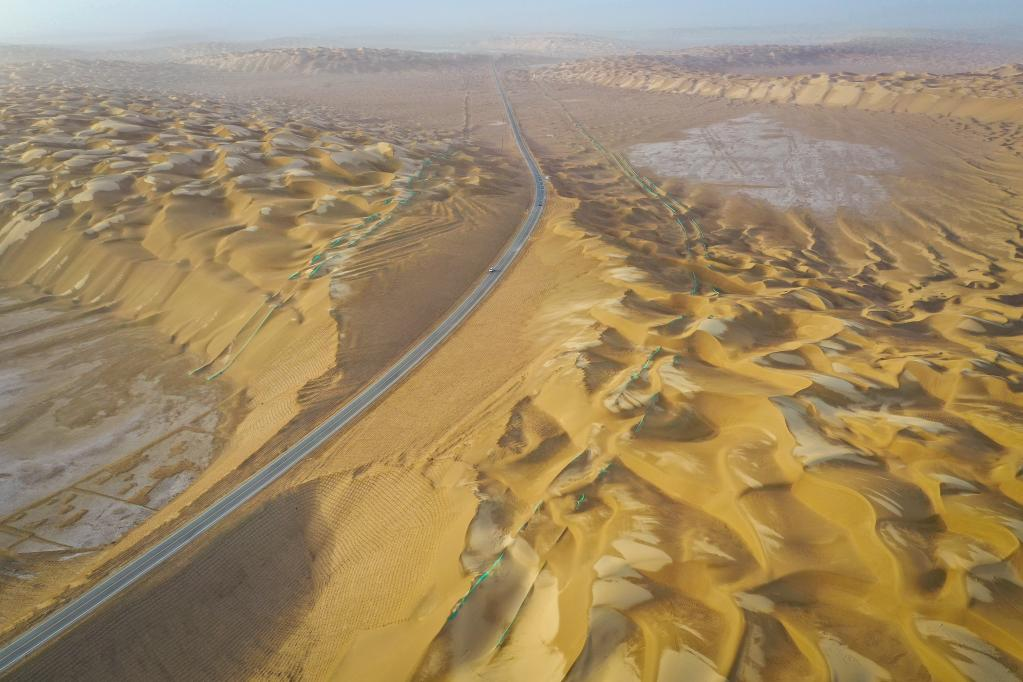
Aerial photo shows a new highway traversing the Taklimakan Desert in northwest China's Xinjiang Uygur Autonomous Region, June 26, 2022. Located in south Xinjiang's Bayingolin Mongolian Autonomous Prefecture, the highway, connecting Yuli County and Qiemo County, was put into operation on Thursday. The highway is the third one across the Taklimakan Desert, the world's second-largest shifting-sand desert.
With a designed speed of 60 or 80 km per hour for different sections, the highway has a total length of 334 km, with 307 km passing through the desert. So far, China has more than 1,200 km of highways across the Taklimakan Desert.
The highway has been built with an estimated total investment of about 1.75 billion yuan (about 261.5 million U.S. dollars) and its construction started in October 2017. (Xinhua/Li Xiang)
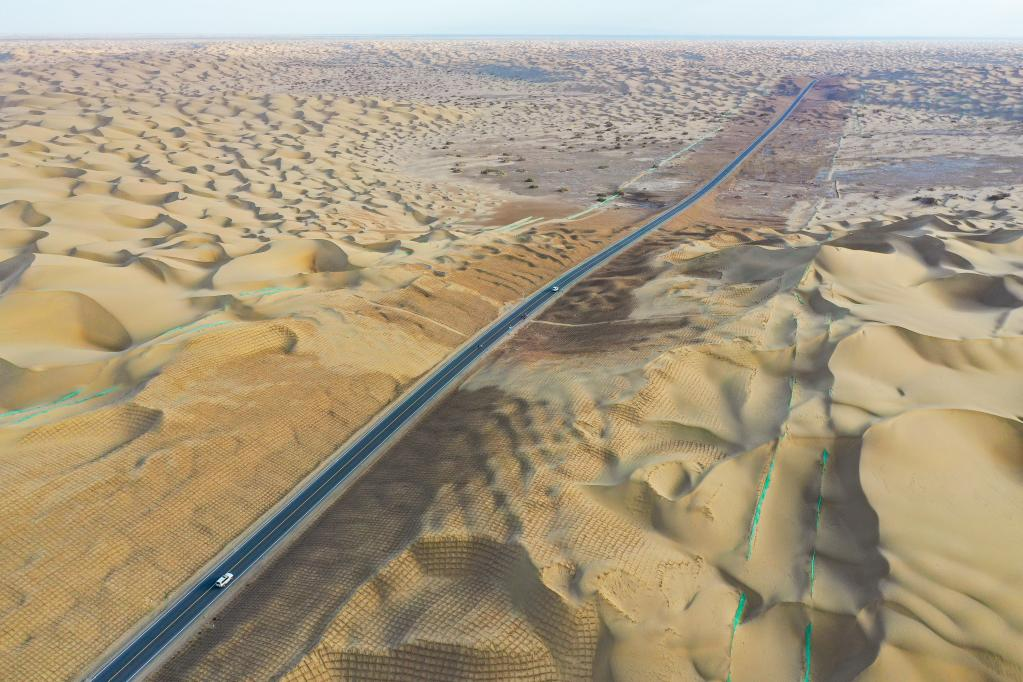
Aerial photo shows a new highway traversing the Taklimakan Desert in northwest China's Xinjiang Uygur Autonomous Region, June 23, 2022. Located in south Xinjiang's Bayingolin Mongolian Autonomous Prefecture, the highway, connecting Yuli County and Qiemo County, was put into operation on Thursday. The highway is the third one across the Taklimakan Desert, the world's second-largest shifting-sand desert.
With a designed speed of 60 or 80 km per hour for different sections, the highway has a total length of 334 km, with 307 km passing through the desert. So far, China has more than 1,200 km of highways across the Taklimakan Desert.
The highway has been built with an estimated total investment of about 1.75 billion yuan (about 261.5 million U.S. dollars) and its construction started in October 2017. (Xinhua/Gu Yu)
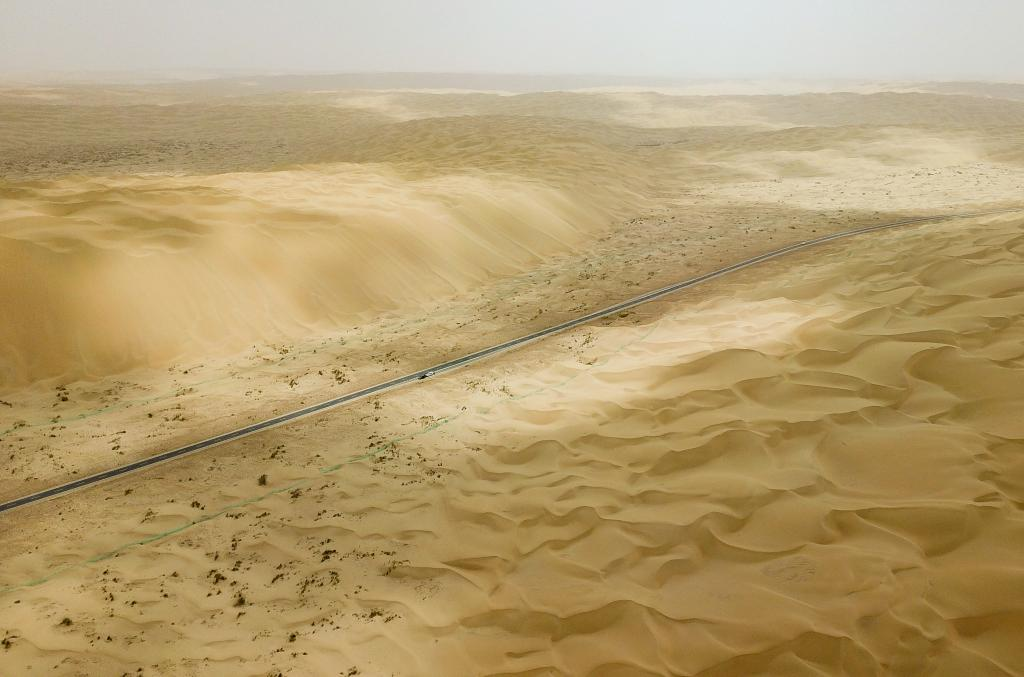
Aerial photo shows a new highway traversing the Taklimakan Desert in northwest China's Xinjiang Uygur Autonomous Region, June 25, 2022. Located in south Xinjiang's Bayingolin Mongolian Autonomous Prefecture, the highway, connecting Yuli County and Qiemo County, was put into operation on Thursday. The highway is the third one across the Taklimakan Desert, the world's second-largest shifting-sand desert.
With a designed speed of 60 or 80 km per hour for different sections, the highway has a total length of 334 km, with 307 km passing through the desert. So far, China has more than 1,200 km of highways across the Taklimakan Desert.
The highway has been built with an estimated total investment of about 1.75 billion yuan (about 261.5 million U.S. dollars) and its construction started in October 2017. (Xinhua/Su Chuanyi)
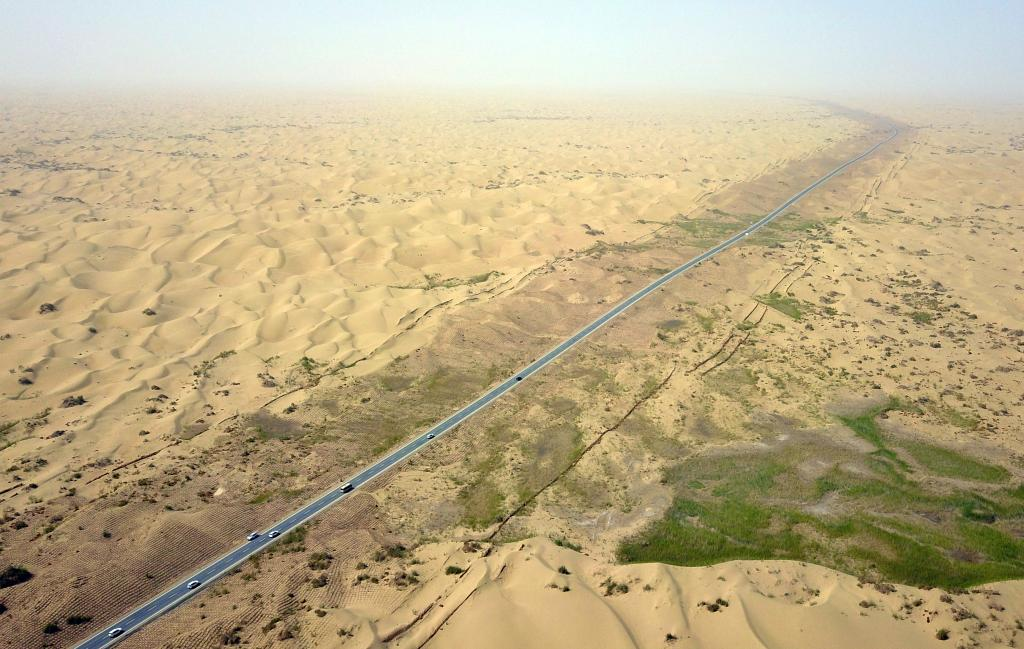
Aerial photo shows cars running on a new highway traversing the Taklimakan Desert in northwest China's Xinjiang Uygur Autonomous Region, June 30, 2022. Located in south Xinjiang's Bayingolin Mongolian Autonomous Prefecture, the highway, connecting Yuli County and Qiemo County, was put into operation on Thursday. The highway is the third one across the Taklimakan Desert, the world's second-largest shifting-sand desert.
With a designed speed of 60 or 80 km per hour for different sections, the highway has a total length of 334 km, with 307 km passing through the desert. So far, China has more than 1,200 km of highways across the Taklimakan Desert.
The highway has been built with an estimated total investment of about 1.75 billion yuan (about 261.5 million U.S. dollars) and its construction started in October 2017. (Xinhua/Gu Yu)
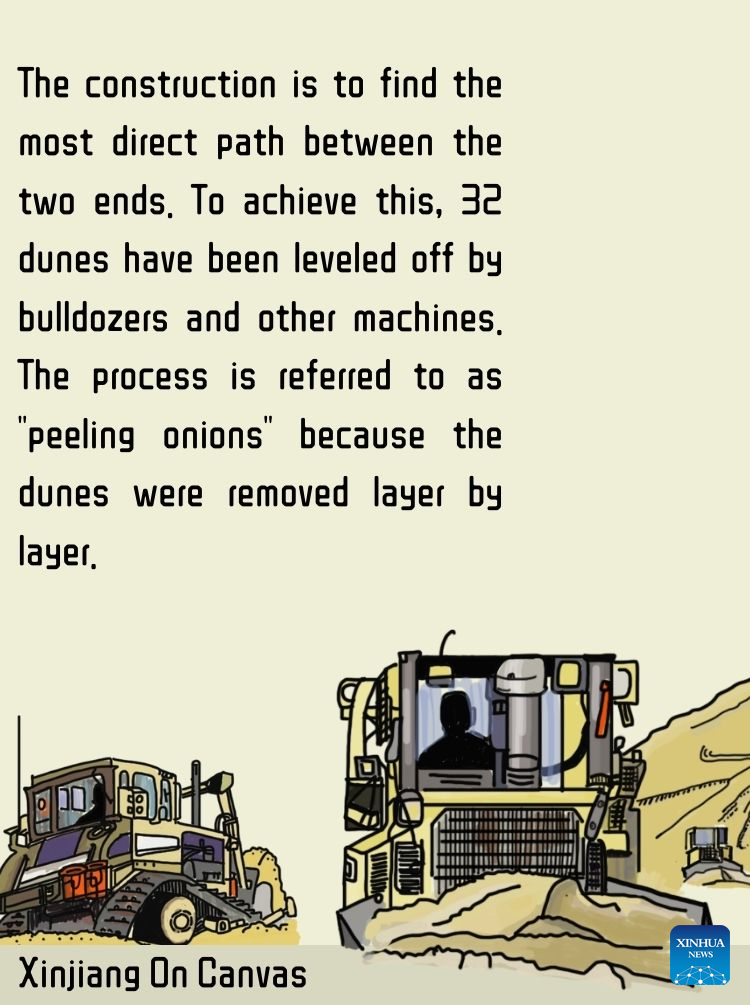
A new highway traversing the Taklimakan Desert in China's northwestern Xinjiang Uygur Autonomous Region, was put into operation on Thursday. Located in south Xinjiang's Bayingolin Mongolian Autonomous Prefecture, the highway, connecting Yuli County and Qiemo County, is the third one across the Taklimakan Desert, the world's second-largest shifting-sand desert.
With a designed speed of 60 or 80 km per hour for different sections, the highway has a total length of 334 km, with 307 km passing through the desert. So far, China has more than 1,200 km of highways across the Taklimakan Desert. (Xinhua/Ma Zegang)
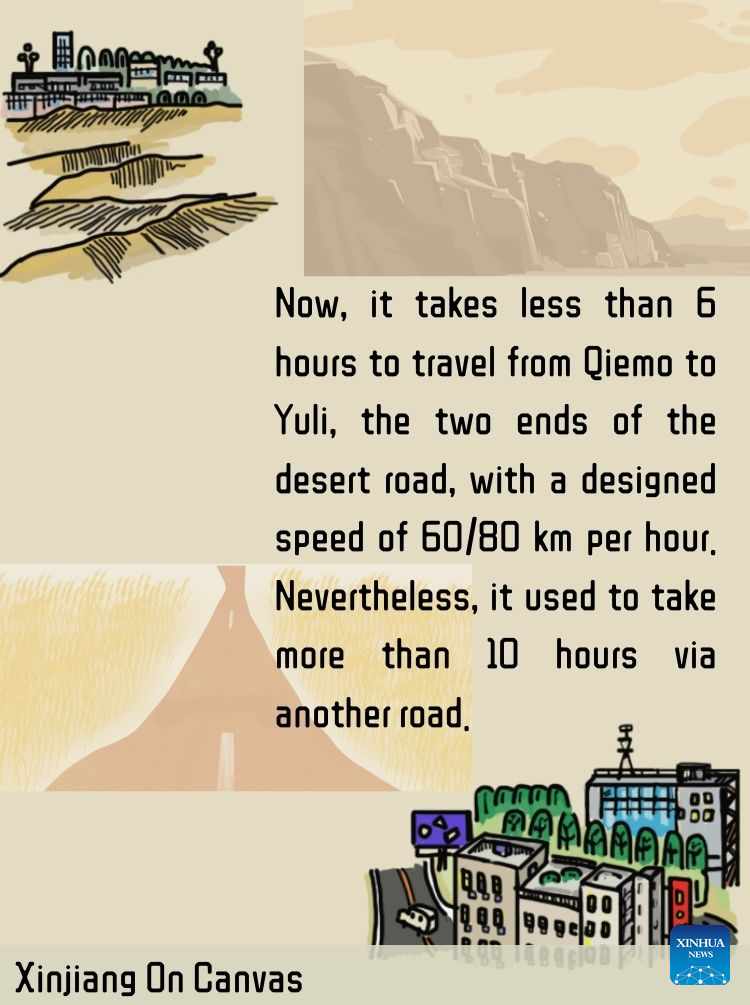
A new highway traversing the Taklimakan Desert in China's northwestern Xinjiang Uygur Autonomous Region, was put into operation on Thursday. Located in south Xinjiang's Bayingolin Mongolian Autonomous Prefecture, the highway, connecting Yuli County and Qiemo County, is the third one across the Taklimakan Desert, the world's second-largest shifting-sand desert.
With a designed speed of 60 or 80 km per hour for different sections, the highway has a total length of 334 km, with 307 km passing through the desert. So far, China has more than 1,200 km of highways across the Taklimakan Desert. (Xinhua/Ma Zegang)
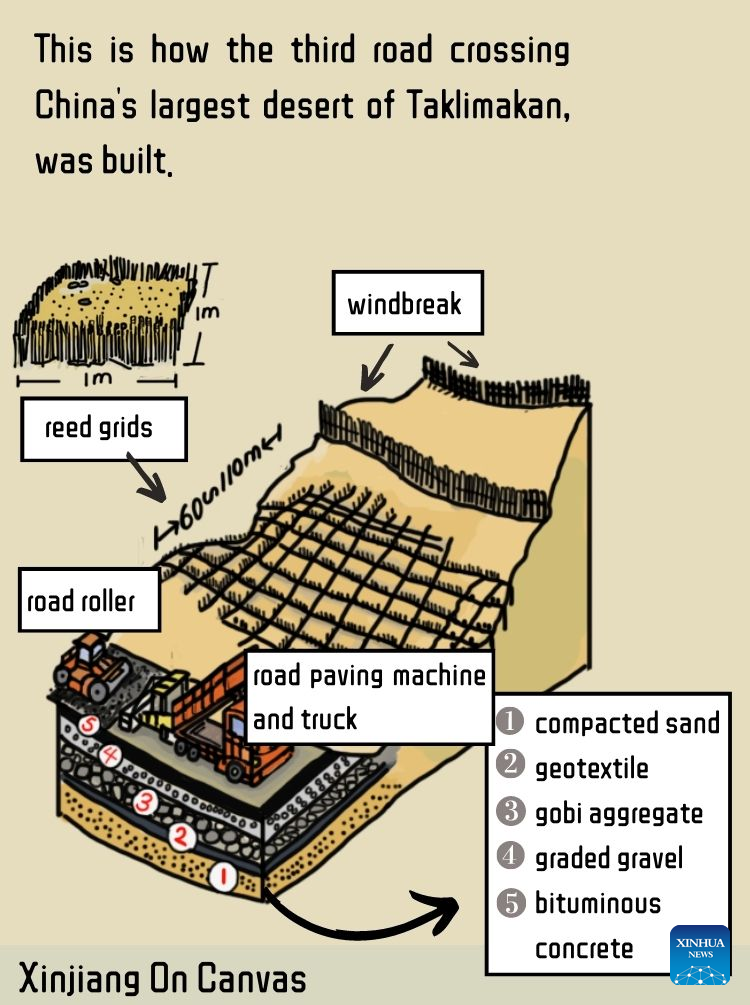
A new highway traversing the Taklimakan Desert in China's northwestern Xinjiang Uygur Autonomous Region, was put into operation on Thursday. Located in south Xinjiang's Bayingolin Mongolian Autonomous Prefecture, the highway, connecting Yuli County and Qiemo County, is the third one across the Taklimakan Desert, the world's second-largest shifting-sand desert.
With a designed speed of 60 or 80 km per hour for different sections, the highway has a total length of 334 km, with 307 km passing through the desert. So far, China has more than 1,200 km of highways across the Taklimakan Desert. (Xinhua/Ma Zegang)
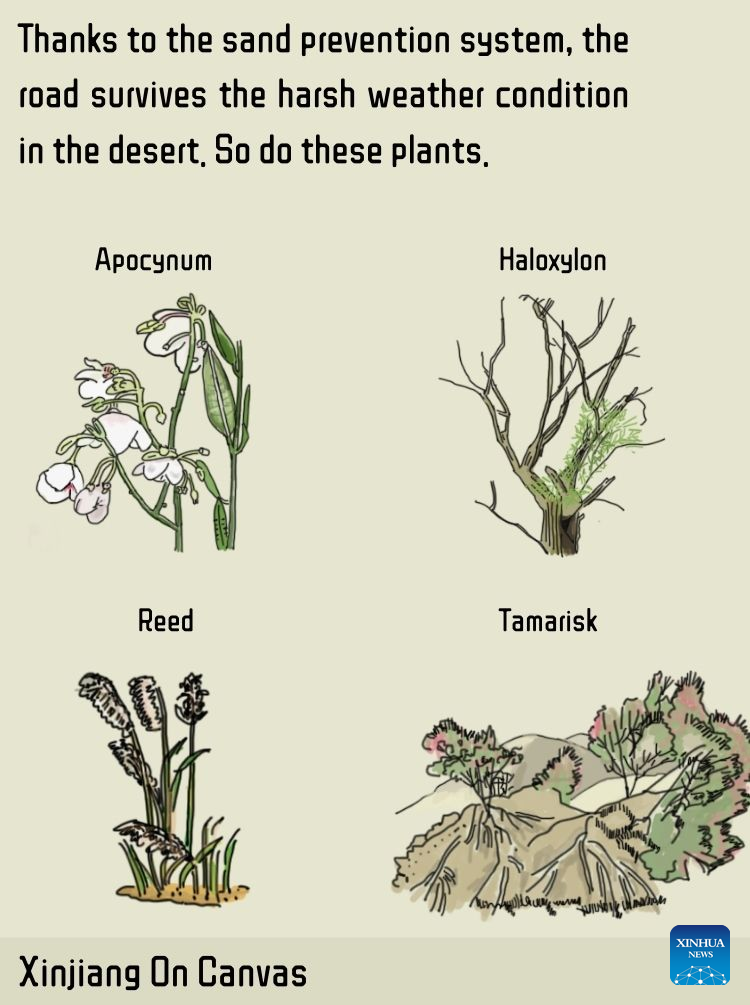
A new highway traversing the Taklimakan Desert in China's northwestern Xinjiang Uygur Autonomous Region, was put into operation on Thursday. Located in south Xinjiang's Bayingolin Mongolian Autonomous Prefecture, the highway, connecting Yuli County and Qiemo County, is the third one across the Taklimakan Desert, the world's second-largest shifting-sand desert.
With a designed speed of 60 or 80 km per hour for different sections, the highway has a total length of 334 km, with 307 km passing through the desert. So far, China has more than 1,200 km of highways across the Taklimakan Desert. (Xinhua/Ma Zegang)



